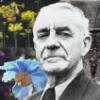Comments
from Mr. PGC: Throughout
history, many people have made lasting contributions to the
world of plants. In these pages, we hope to pay tribute to
some of them. Our concentration will be primarily on those
who have introduced plants to the gardening world, those who
have helped spread the word about gardening and those who
have made significant contributions to landscaping and
landscaping design around the world.
This list will be constantly growing as we add
new names. If you have someone who you think should be on
the list, please send us an
Email.
|
|
|
 |
 |
|
|
 |
|
Jim Wilson |
|
 |
|
 |
 
|
|
 |
|
 |
 Kevin
Walek was the
Registrar for the Genus, Hosta from
2005 to 2015. He lives in Virginia and has been active in
hybridizing hostas for many years. Kevin was the President
of
The American Hosta Society
from 2003 to 2005 and was
awarded the Alex J. Summers Distinguished Merit Award in
2005. He has also served as the Registrar for the Genus,
Hemerocallis (Daylilies) and was President of the
American Hemerocallis Society. Kevin
Walek was the
Registrar for the Genus, Hosta from
2005 to 2015. He lives in Virginia and has been active in
hybridizing hostas for many years. Kevin was the President
of
The American Hosta Society
from 2003 to 2005 and was
awarded the Alex J. Summers Distinguished Merit Award in
2005. He has also served as the Registrar for the Genus,
Hemerocallis (Daylilies) and was President of the
American Hemerocallis Society.
|

|
|
 |
|
 |
Austrian botanist and
author. The specific epithet,
Waldsteinia,
aka Barren Strawberry, was named
for him.

|
|
 |
|
 |
 Garden designer in the style of
Gertrude Jekyll
who was born in Devon,
England.
She accompanied her family first to
New Zealand then
on to
settle in
Australia. In the 1920s she developed a village with
'English' gardens at Mooroolbark,
Australia. Garden designer in the style of
Gertrude Jekyll
who was born in Devon,
England.
She accompanied her family first to
New Zealand then
on to
settle in
Australia. In the 1920s she developed a village with
'English' gardens at Mooroolbark,
Australia.
She wrote for Australian Home
Beautiful and the books Gardens in Australia (1943),
Cottage and Garden (1947) and A Gardener's Log (1948).

|
|
 |
|
 |
 Frank Kingdon Ward traveled widely in the
Himalayas
as a plant explorer for a period spanning 45 years. During that
time, he
published several readable accounts of his experiences included The Riddle of the Tsangpo Gorges and The
Romance of Plant Hunting. Frank Kingdon Ward traveled widely in the
Himalayas
as a plant explorer for a period spanning 45 years. During that
time, he
published several readable accounts of his experiences included The Riddle of the Tsangpo Gorges and The
Romance of Plant Hunting.
 During his trips
to
Tibet,
Burma (Myanmar)
and
China, Kingdon collected unusual plants from several genera
including
Primula,
Lilium,
Rhododendron and Gentiana
which he brought back to
England. He studied the distribution of
the Meconopsis
aka Himalayan Blue Poppy,
during his time in
Tibet. During his trips
to
Tibet,
Burma (Myanmar)
and
China, Kingdon collected unusual plants from several genera
including
Primula,
Lilium,
Rhododendron and Gentiana
which he brought back to
England. He studied the distribution of
the Meconopsis
aka Himalayan Blue Poppy,
during his time in
Tibet.
Plants he collected included
Meconopsis bentonicifolia,
Cotoneaster conspicuus,
Cotoneaster sternianus,
Cotoneaster wardii,
Primula alpicola,
Primula
burmanica and
Rhododendron wardii.

|
|
 |
|
 |

First
President of
United States for whom the genus,
Washingtonia (a genus of
palm trees) was named.
Plants named for his
home,
Mount Vernon, include Picea orientalis 'Mount
Vernon' and
Prunus laurocerasus 'Mount Vernon'.

|
|
 |
|
 |
 
|

|
|
 |
|
 |
 German
physician and botanist for whom
the genus of ornamental shrubs,
Weigela, was named.
He was a professor of Chemistry, Pharmacy, Botany, and
Mineralogy at the University of Greifswald. German
physician and botanist for whom
the genus of ornamental shrubs,
Weigela, was named.
He was a professor of Chemistry, Pharmacy, Botany, and
Mineralogy at the University of Greifswald.

|
|
 |
|
 |
 Host
of PBS' The Victory Garden
television program
for five years starting in
2002 and ending in 2007. He owns a landscape design firm. Host
of PBS' The Victory Garden
television program
for five years starting in
2002 and ending in 2007. He owns a landscape design firm.

|
|
 |
|
 |
 
|
|
 |
|
 |
 Miss Willmott is known for her garden at Warley Place in Essex,
England,
part of which became a reserve for the Essex Naturalists' Trust in
1978, though little of her garden remains. She became renowned for
her knowledge of plants, her patronage of plant hunters (notably
Ernest Wilson), the book she published on
roses and her prickly
temperament. Her habit of scattering seeds of
Eryngium aka
'Miss Wilmott's ghost' in friend's gardens didn't endear her to
those who didn't especially fancy sea holly! She developed the
garden at Boccanegra on the Italian Riviera. Miss Willmott is known for her garden at Warley Place in Essex,
England,
part of which became a reserve for the Essex Naturalists' Trust in
1978, though little of her garden remains. She became renowned for
her knowledge of plants, her patronage of plant hunters (notably
Ernest Wilson), the book she published on
roses and her prickly
temperament. Her habit of scattering seeds of
Eryngium aka
'Miss Wilmott's ghost' in friend's gardens didn't endear her to
those who didn't especially fancy sea holly! She developed the
garden at Boccanegra on the Italian Riviera.
The specific
epithets of warleyensis and willmottianum are
named for her. Plants associated with these names include:
Iris warleyensis,
Campanula 'Warleyensis',
Epimedium warleyensis
'Ellen Willmott',
Rosa warleyensis, Lysionotus
warleyensis,
Corylopsis warleyensis,
Ceratostigma willmotti,
and
Potentilla nepalensis ‘Miss Willmott’

|
|
 |
|
 |
 One of the most famous plant hunters,
Wilson collected in
Asia
for Harry Veitch's nursery and others including the
Arnold
Arboretum between 1906 and 1919. He served as the Director at Arnold until his death
in a car accident in 1930. One of the most famous plant hunters,
Wilson collected in
Asia
for Harry Veitch's nursery and others including the
Arnold
Arboretum between 1906 and 1919. He served as the Director at Arnold until his death
in a car accident in 1930.
Wilson was a renowned explorer and is credited with "discovering" between 3,000 and 5,000 species
during his many trips to
China.
 Among the
new plants he introduced to Europe is the easily grown and
popular
Lilium regale. Other introductions include the
Acer griseum (paperbark
maple),
Davidia involucrata (The 'Handkerchief Tree'),
Kolkwitzia
amabilis,
Cornus controversa (the giant dogwood) and
Magnolia
wilsonii. Among the
new plants he introduced to Europe is the easily grown and
popular
Lilium regale. Other introductions include the
Acer griseum (paperbark
maple),
Davidia involucrata (The 'Handkerchief Tree'),
Kolkwitzia
amabilis,
Cornus controversa (the giant dogwood) and
Magnolia
wilsonii.
Plants bearing his name include
Acer wilsonii,
Corydalis wilsonii,
Exochorda giraldii var.
wilsonii,
Gentiana wilsonii,
Hypericum wilsonii,
Magnolia
wilsonii,
Primula wilsonii,
Syzygium wilsonii and
Trachelospermum jasminoides 'Wilsonii'.

|
|
 |
|
 |
 Jim Wilson appeared for 10
years as co-host of the PBS' television series, The Victory Garden
and
as host of
HGTV's Great Gardener series. He worked in
the horticulture
industry for over 50 years and was
a well-known
author. Jim Wilson appeared for 10
years as co-host of the PBS' television series, The Victory Garden
and
as host of
HGTV's Great Gardener series. He worked in
the horticulture
industry for over 50 years and was
a well-known
author.
 Among his published works are:
Landscaping with
Wildflowers, Landscaping with Herbs, South
Carolina Gardeners Guide, Bulletproof Flowers for the
South, and Jim Wilson's Container Gardening. Jim was
past president of the Garden Writers Association of America, a
member of its hall of fame, and spokesperson for its Plant a Row
for the Hungry program. Among his published works are:
Landscaping with
Wildflowers, Landscaping with Herbs, South
Carolina Gardeners Guide, Bulletproof Flowers for the
South, and Jim Wilson's Container Gardening. Jim was
past president of the Garden Writers Association of America, a
member of its hall of fame, and spokesperson for its Plant a Row
for the Hungry program.

|
|
 |
|
 |
 English Queen Anne's master gardener and the last of British
'Formalists', Henry Wise was superintendent of the royal gardens
at the recently restored King's Privy
Garden for William III at
Hampton Court
Palace.
These gardens were recorded in the panoramic painting by Leonard Knyff. English Queen Anne's master gardener and the last of British
'Formalists', Henry Wise was superintendent of the royal gardens
at the recently restored King's Privy
Garden for William III at
Hampton Court
Palace.
These gardens were recorded in the panoramic painting by Leonard Knyff.
In
partnership with George London, Henry Wise is associated with
aspects of the design of gardens at
Studley Royal, Castle Howard
and
Newby Hall in Yorkshire and at
Blenheim Palace
in Oxfordshire and Chatsworth in Derbyshire.

|
|
 |
|
 |
 The genus,
Wisteria (spelled with an
e for some reason) was named after this professor of
anatomy at the University of Pennsylvania by the plant explorer,
Thomas Nuttall
in 1818. The genus,
Wisteria (spelled with an
e for some reason) was named after this professor of
anatomy at the University of Pennsylvania by the plant explorer,
Thomas Nuttall
in 1818.

|
|
 |
|
 |

Dr John Casper Wister (1887-1982) was a graduate of Harvard’s
School of Landscape Architecture in 1909. He was a professor at
Swarthmore College for 50 years. He also became director of the
John J. Tyler Arboretum in Lima, PA while continuing his
research on hybrids of ornamental plants and flowers at
Swarthmore.
Dr Wister and his wife were among
the founders of The American Hosta Society which held its first
meeting at Swarthmore in 1968. He was also a member and officer
in the American Rose Society, Pennsylvania Horticultural
Society, the John Bartram Association and was a founder and
President of the American Iris Society.
Among the awards Dr Wister
recieved was the Liberty Hyde Bailey Medal, the A.P. Saunders
Memorial Award from the American Peony Society, the Garden Medal
from the Brooklyn Botanic Garden and the Royal Horticultural
Society dedicated its Daffodil and Tulip Yearbook to him in
1966. The Wister Medal of the American Iris Society is named in
his honor.
|

|
|
 |
|
 |
  Wyman served as
Horticulturist of The
Arnold Arboretum of Harvard University in
Jamaica Plain, Massachusetts from 1935-1970. He was instrumental
in introducing many new species to the arboretum as well as to
the
United States in general. He earned a B.A. from Penn State
and his Ph.D. from Cornell University. Wyman served as
Horticulturist of The
Arnold Arboretum of Harvard University in
Jamaica Plain, Massachusetts from 1935-1970. He was instrumental
in introducing many new species to the arboretum as well as to
the
United States in general. He earned a B.A. from Penn State
and his Ph.D. from Cornell University.
Wyman was the editor of the
publication, ‘Arnoldia’ and wrote several books including Shrubs and Vines for American Gardens,
Trees for American
Gardens, and Wyman's Gardening Encyclopedia. He also
served as president, director, and trustee of the American
Horticultural Society and trustee of the Massachusetts
Horticultural Society.

|
|

